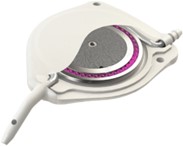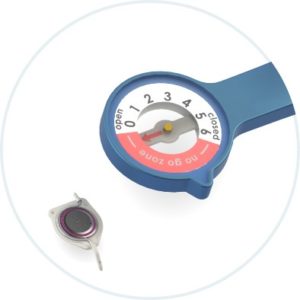In our previous article, we discussed the traditional treatments for glaucoma. While effective in slowing the progression of the disease, they have some limitations: potential side effects, uncertain long-term efficacy, and challenges for patients in adhering to treatments over a prolonged period. These limitations highlight the need for innovation to provide optimized and sustainable care for patients.
- More Effective Treatments
The goal is to develop therapies that stabilize the disease and, ideally, restore lost vision. These new approaches aim to ensure lasting efficacy without the need for constant treatment repetition. - Reduction of Side Effects
Minimizing side effects is crucial to improving patients’ quality of life and reducing the risks associated with current treatments. - Improved Follow-Up
Innovation also focuses on creating less demanding treatments, facilitating patient adherence. Simplified follow-up contributes to better disease control, ensuring long-term stability.
These advancements open promising perspectives for glaucoma management, offering patients hope for better disease control and an improved quality of life.
The MIGS Techniques
Minimally Invasive Glaucoma Surgery (MIGS) represents a breakthrough in glaucoma treatment. These techniques use micro-drainage implants to facilitate the drainage of aqueous humor, the fluid whose excess causes elevated intraocular pressure and can lead to glaucoma. By improving drainage, these implants help regulate pressure in a balanced manner.
Compared to traditional surgeries, MIGS techniques offer several advantages:
- Shorter and less invasive implant procedures: Surgeries are typically faster and less invasive.
- Reduced surgery duration: Less time spent in the operating room also translates to quicker recovery for patients.
- Fewer post-operative visits: The post-operative follow-up is less demanding, improving patients’ quality of life.
In comparison with eye drop treatments, MIGS techniques allow for more stable and regular pressure levels. These innovations provide patients with an effective and less burdensome alternative, reducing the daily treatment load and improving glaucoma management.

MIGS devices must meet five specific criteria to be classified as part of this innovative category:
- Ab interno approach: Performed from the inside, preserving the conjunctiva.
- Minimal tissue trauma: Reduced handling of ocular tissues.
- Proven efficacy: Demonstrated ability to lower intraocular pressure (IOP).
- High safety standards: Few or no major complications.
- Rapid recovery: Minimal impact on patients’ quality of life.
Examples of MIGS Techniques
- iStent Trabecular Stents: Among the most popular MIGS devices, these stents effectively reduce IOP with minimal side effects and rapid recovery.
- Selective Laser Trabeculoplasty (SLT): This technique uses a laser to enhance aqueous humor drainage, noninvasively lowering IOP.
- Canaloplasty: By using a catheter to dilate Schlemm’s canal, this technique increases aqueous humor drainage and helps control IOP.
- Subconjunctival implants and shunts: These devices, placed beneath the conjunctiva, also facilitate aqueous humor drainage.
MIGS techniques provide effective and less invasive alternatives to traditional glaucoma treatments, enabling patients to benefit from IOP reduction with fewer risks and side effects.
Which Technique to Choose?
Minimally Invasive Glaucoma Surgery (MIGS) techniques are primarily recommended for patients with open-angle glaucoma, especially when the disease is at an early or moderate stage. MIGS is also suitable in cases where glaucoma and cataracts need to be treated simultaneously, often during the same surgical procedure.
Criteria for Choosing the MIGS Technique:
To select the most appropriate MIGS technique, several factors must be taken into account:
- The stage of disease progression: The choice of technique may vary depending on the severity of glaucoma.
- Ocular characteristics: The condition of the conjunctiva and cornea can influence the recommended technique.
- Angle anatomy: The configuration of the iridocorneal angle plays a role in the choice of technique.
For patients with advanced glaucoma, more invasive surgeries, such as trabeculectomy or non-perforating deep sclerectomy, as well as valvular drainage devices, may be recommended.

Potential Risks
While MIGS devices reduce the risks associated with traditional glaucoma surgery, some complications, though rare, can occur:
- Mild intraocular bleeding: During the procedure, small amounts of bleeding may occur inside the eye. This can cause temporary blurry vision for a few weeks as the bleeding resolves.
- Gradual loss of hypotensive effect: As with all glaucoma surgeries, the effectiveness of MIGS implants in reducing intraocular pressure may decrease over time, often due to tissue scarring or fibrosis. Additional measures may be required to maintain pressure control.
- Risk of infection: Though very rare, infections are a potential risk, as with any surgical procedure.
Despite these risks, they remain minimal compared to the potential benefits offered by MIGS techniques, providing patients with an effective and less invasive treatment option for glaucoma.
Classic Surgeries for Glaucoma Treatment: Focus on Trabeculectomy
While minimally invasive techniques (MIGS) are gaining popularity, traditional surgeries remain essential in the treatment of advanced or treatment-resistant glaucoma. Trabeculectomy is one of the most commonly performed surgeries to lower intraocular pressure (IOP) when medication and MIGS techniques are insufficient.
What is Trabeculectomy?
Trabeculectomy is a surgery that creates a new drainage channel for aqueous humor, allowing this fluid to exit the eye and thus reduce intraocular pressure. This procedure aims to prevent further damage to the optic nerve by maintaining controlled IOP levels.
During the procedure, the ophthalmic surgeon creates a small opening in the sclera (the outer wall of the eye) to facilitate aqueous humor drainage. The fluid is redirected to a reservoir under the conjunctiva (the transparent membrane covering the eye), where it is naturally absorbed.
Indications for Trabeculectomy
Trabeculectomy is often recommended in the following cases:
- Advanced open-angle glaucoma: When intraocular pressure is difficult to control with medications or less invasive techniques.
- Failure of prior treatments: When eye drops, MIGS, or laser treatments have not been able to stabilize IOP.
- Rapidly progressing glaucoma: To limit vision loss in cases where glaucoma advances quickly despite other treatments.
Advantages and Limitations of Trabeculectomy
Although this surgery is effective in reducing IOP, it also has advantages and limitations that are important to understand.
Advantages:
- Proven effectiveness: Trabeculectomy is known for its ability to control intraocular pressure, particularly in cases of advanced glaucoma.
- Reduction in medication use: This procedure can reduce or even eliminate the need for daily glaucoma eye drops.
Limitations:
- Risk of complications: While common, trabeculectomy is not without risks. It can cause infections, bleeding, excessive scarring, or fluctuations in postoperative IOP.
- Long recovery time: Recovery may take several weeks, requiring frequent visits to the ophthalmologist to monitor IOP and adjust treatment if needed.
- Temporary vision loss: Some patients may experience blurry vision or discomfort temporarily after surgery.
Follow-Up and Precautions After Trabeculectomy
After trabeculectomy, regular follow-up is essential to ensure the success of the procedure and prevent complications. Here are some precautions and steps for postoperative care:
- Frequent visits: Regular follow-ups during the first few weeks are necessary to monitor the drainage channel’s functionality.
- Eye care: Antibiotic and anti-inflammatory drops are often prescribed to prevent infections and reduce inflammation.
- Avoid certain activities: During recovery, patients should avoid intense physical activities, heavy lifting, or rubbing their eyes to prevent healing issues.
Alternatives to Trabeculectomy
For some patients, less invasive alternatives like laser trabeculoplasty or MIGS techniques may be considered. However, trabeculectomy remains a key surgery in glaucoma treatment, especially for advanced cases. Despite its risks and the need for careful postoperative follow-up, it offers an effective solution to reduce intraocular pressure and protect the optic nerve.
Focus on Rheon Medical’s EyeWatch™
This solution is designed for patients for whom traditional medical and surgical treatments have not provided satisfactory results. It aims to preserve the optic nerve, a vital structure for vision, and to minimize postoperative complications, thereby reducing the need for additional interventions. This innovative approach offers a valuable alternative for patients with advanced glaucoma, enabling better disease control with minimal impact on their quality of life.

The EyeWatch™ device offers an innovative and effective solution for glaucoma treatment by addressing challenges where traditional methods fall short. Here are the key advantages:
- Adjustable Drainage System: The system allows precise adjustments to treatment for each patient by tailoring intraocular pressure (IOP) and aqueous humor flow rates in real-time.
- Reduction in the Need for Medications and Surgical Interventions: EyeWatch™ minimizes reliance on medications and prevents complications that would require major surgical interventions.
- Non-Invasive Adjustments: The EyeWatch™ can be adjusted without requiring additional surgical procedures
- High Procedural Safety: The surgery is safe and carries a very low risk of infection.
EyeWatch™ Surgical Procedure
The EyeWatch™ is the first and only adjustable glaucoma drainage implant in the world. Its unique mechanism enables surgeons to manage IOP effectively, painlessly, and non-invasively.
Procedure Overview:
The system is designed to drain aqueous humor from the anterior chamber of the eye to the subconjunctival space, enabling non-surgical regulation of IOP during the postoperative period. The procedure involves inserting a tube connecting the intraocular space to the implant placed under the conjunctiva, facilitating the drainage of aqueous humor. This surgery is performed under local anesthesia.
To find out more, watch our eyeWatch video.
Regulating the Implant:
Adjustments to the EyeWatch™ implant are made non-invasively using the EyeWatch™ Pen. This device, equipped with a compass, allows ophthalmologists to precisely control IOP. By aligning and rotating the pen near the implant, the magnetic internal disk of the implant adjusts fluid resistance. This process takes about one minute and is entirely painless for the patient. Watch the video.
Conclusion
While trabeculectomy remains a cornerstone for advanced glaucoma treatment, innovations like MIGS and the EyeWatch™ implant represent significant progress in managing the disease. Unlike traditional surgeries, the EyeWatch™ offers a customizable and non-invasive approach to controlling IOP, reducing the need for further interventions, and enhancing patient comfort. This unique system provides effective drainage, minimizes complications, and improves postoperative outcomes.
The EyeWatch™ system stands out as an optimal choice for patients seeking an efficient and less burdensome treatment, offering better IOP control and an improved quality of life. By regularly consulting an ophthalmologist and staying informed about medical advancements, patients can benefit from the most suitable solutions for their condition.
Continuous innovation in glaucoma device technology, as demonstrated by the EyeWatch™, reflects the commitment to sustainably improving patients’ lives.

